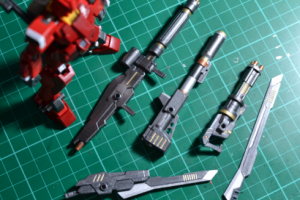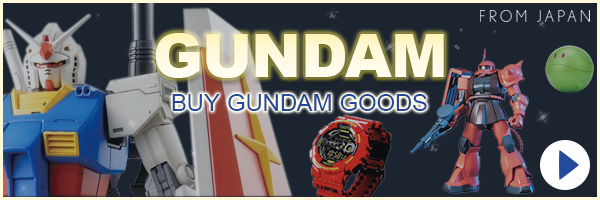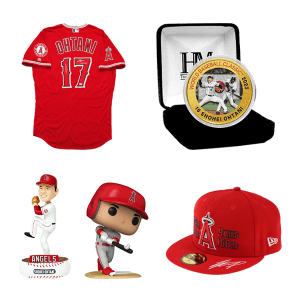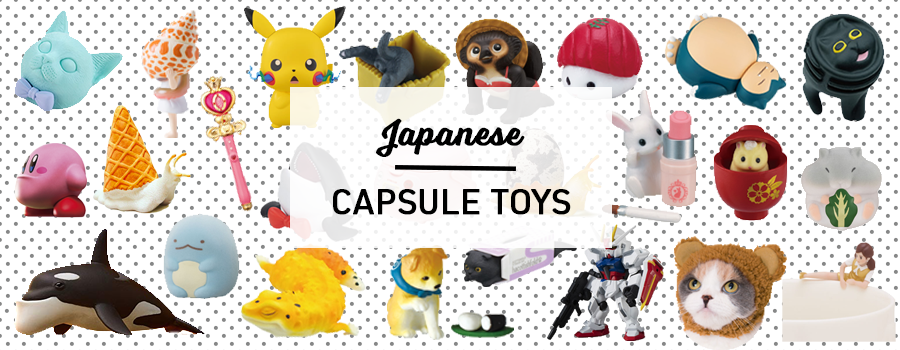After building your first few Gundam kits, there will come a time when you may feel the need to step up your game. One of the things that you can do to improve your Gunpla kit is painting. You can use spray cans and airbrush kits but they are expensive and might we add—dangerous to use indoors. Some people will want to opt for cheaper and safer methods like hand painting with acrylics. Today we’ll show you how to paint using Tamiya Acrylic paints. Be sure to check out the bottom for videos!
First you will need to prepare some materials for your Gunpla hand painting project; these include:
Paint Brushes
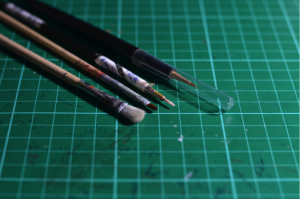
There are four recommended types of brushes (refer to the image above when reading each brush’s description):
a. Flat Brush
The flat brush is the one on the left-most side of the photo. It’s used to apply base coats or painting large parts or areas.

b. Small Flat Brush
The small flat brush is the one second to the left. It’s used to paint smaller details that have a rectangular like surface area like rims of weapons or thrusters.

c. Small Pointed Round Brush
The small pointed round brush is the one with white bristles. It’s used for painting smaller generic details and small areas like hydraulics and pipes.

d. Detail Round Brush
As far as brushes go, the detail round brush is a great investment. This will help you paint the smallest of details with pinpoint accuracy and precision. Coupled with steady hand techniques, you’ll be painting the smallest of details in no time. Like painting the small vulcans on an Amazing Red Warrior’s head unit (see below).
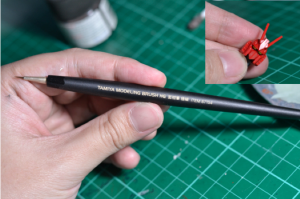
Pro Tip: Caring for Brushes
It’s important to take care of your brushes especially the smaller ones so that the brush ends won’t get damaged or frizzed which would make painting harder and messy. Don’t let the paint dry on your brush, as soon as you’re done using the brush, dip it in water and let it sit there for a while for the paint to soften. Then you can clean it further using cotton buds or swabs and carefully remove paint residues from the brush tip.
Spray
Tamiya Paint
A great brand for Gundam model enthusiasts is Tamiya Acrylic Paint, due to the wide selection of colors to choose from.
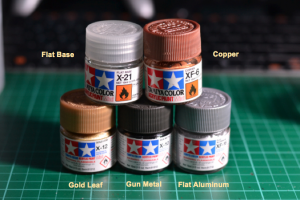
The 5 above are considered to be essential colors, and include:
- Flat Base
- Copper
- Gold Leaf
- Gun Metal
- Flat Aluminum
You can use these basic metallic colors to easily make your Gunpla kit look more realistic. One of the most basic techniques is to paint the joints, hydraulics, pipes and any other parts that should look like metal with Gun Metal, then paint the smaller details using the combination of Gold Leaf, Copper and Flat Aluminum. There are more metallic colors to choose from like metallic blue, it’s up to your discretion which combination you would like to use. After all Gunpla painting is art.
Flat Base is used as a primer so that paint will stick properly to the plastic surface, especially on colored parts. However, it’s good to note that you probably don’t need to use a primer when painting grey joint parts using the metallic paints like Gun Metal because metallic paints are easier to adhere to the plastic surface for some reason compared to normal opaque paints. This tip can reduce the time and effort when improving your Gunpla kit.
Pro Tip: Caring for Paint Bottles
Yes, paint bottles are also need to be looked after. Or else, you will end up one day needing one of your paints but can’t open it anymore because the lid is dried shut. This happens when you use the paint bottle edges in removing excess paint from your brush. Don’t do that! Instead use a paint mixing spoon to take paint out of the bottle and into a mixing palette, then close the bottle immediately to avoid exposure to air that can reduce the quality of your acrylic paint. Do not shake your paint bottle, too! As you will risk paint spilling on the rims that can dry up and lock up your bottle. Just use the paint mixing spoon that is discussed below when mixing paint that has begun to separate.
Paint Mixing Spoons
And here are the paint mixing spoons. They are easy to clean, just use some paint thinner and cotton swabs. As mentioned, these are mainly used when mixing paint in the bottles and transferring the paint to a mixing palette.
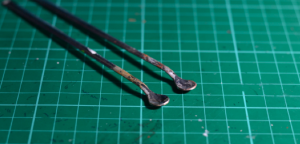
Paint Thinner
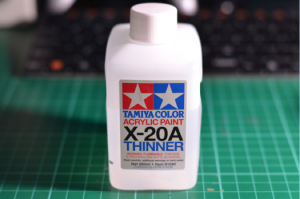
Paint thinner is by far one of the most important materials that you will need when hand painting your Gunpla kit. As the label says “Thinner”, it just does that—it thins your paint! Why thin your paint? Well it’s because most acrylic paints straight from the bottle are thick and dry quickly. This will cause a lot of problems when painting like bubbles, visible paint brush strokes, paint drips and an assortment of other hand painting horrors that you can easily prevent by using this wonderful product.
After getting a generous amount of paint from the bottle using the paint mixing spoons, you can then add a few drops of thinner, using some paint droppers, to the paint in the mixing palette. There isn’t a strict ratio of thinner-to-paint mixture as paint thickness and fluidity varies from color to color and humidity. Most metallic paints like Gun Metal and Gold Lead are generally thicker in consistency, what you want to achieve is a milky consistency, not too thin and not too thick. Usually 5–10 drops of thinner is enough for 3 mixing spoons of metallic paint. You will get the hang of the ratio once you’ve experienced doing this. The main advantage of thinning your paint is that the paint will automatically even out after hand painting your parts. At first you will feel like it’s not evening out, you have wait for a few seconds and observe as the paint will even out on the surface by itself, removing the paint brush strokes in the process and producing a nice smooth finish.

You can also use this to strip non-metallic paints afterwards if you didn’t like the color you painted. Note that metallic paints are harder to strip because they have metallic particles that really adhere well to the plastic surface. If you happen to need to strip metallic paint, you have to do it as soon as you have painted the surface, because if you let it dry, your work multiplies.
Cotton Swabs
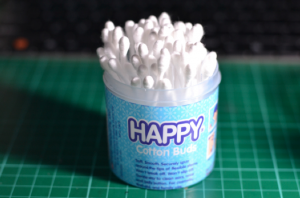
Cotton swabs coupled with small amounts of thinner can be used to clean parts that you accidentally dab some paint on. You can also use them for stripping paint, as well as cleaning your brushes and mixing spoons.
Water
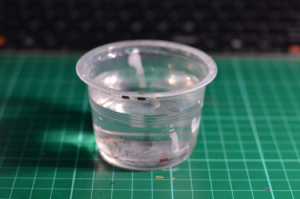
You need to clean your brushes after every painting session. Preferably, you will have multiple sets of brushes so that you don’t need to use the same brush for multiple colors in one session. For example, if you are painting both Gun Metal and Gold Leaf with a small flat brush, you can soak the Gun Metal brush in water while you use Gold Leaf brush.
Pro Tip: Caution with Water
Don’t use water to thin your acrylic paints. It acts different in thinning compared to the actual acrylic thinner.
Paint Droppers
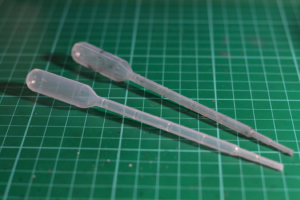
Paint droppers are designed to easily transfer paint from the bottle to the palette, however, as mentioned above mixing spoons work great for this task. Instead, these droppers serve the purpose of easily dropping the right amount of thinner onto the mixing palette to obtain the perfect consistency.
Mixing Palettes
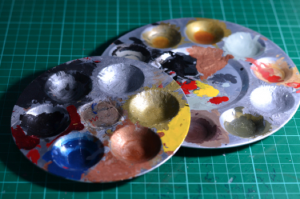
There isn’t much to discuss when it comes to mixing palettes. Some people prefer metal and some prefer plastic; it’s really up to you.
Bamboo Sticks, Clips, Sticky Tacks & Styrofoam
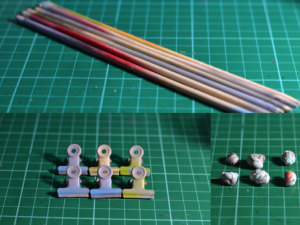
Bamboo sticks combined with some small clips or sticky tacks are great method for holding Gunpla parts while painting and sticking them to a Styrofoam for drying. And, they’re easy enough to make!
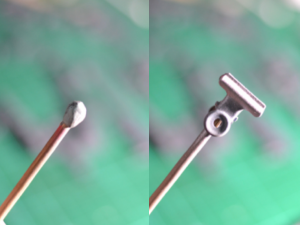
After painting your parts, you can stick them on to the Styrofoam for drying like this:
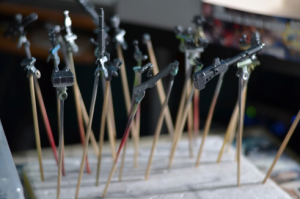
More Gundam Painting Tips
• Make sure you have a nice sturdy table to work on, you can rest your wrist on the table for added stability to avoid painting in midair as this will cause possible trembling.
• It’s better to paint in a well-ventilated area, even though acrylic paints are safer than spray cans and lacquer based paints, they still create a small amount of fumes.
• An extra light source is helpful when painting, like a desk lamp, so that you don’t have to squint too much while painting and avoid stress on the eyes.
• Always clean your brush after painting a batch of parts.
• Always keep your paint bottles closed after extracting paint from the bottle.
• When painting details, try to paint away from the edges, this usually produces a cleaner finish on the edges.
• If you want to do retouches, wait for the first coat of paint to dry. This usually take around an hour or so, curing takes a longer time usually overnight or more so that the paint will be stronger before putting the parts together.
• The trick in hand painting large areas is to use a single brush stroke direction as much as possible, and also paint fast so that the paint will even out better in totality before the paint dries. It’s when the paint starts to dry up and you want to fix it but it isn’t dry yet that wrinkles, blobs, and an undesirable finish will occur. So in painting large parts, paint as fast as you can before the paint dries up to achieve a smooth finish. It is okay if some areas are not painted well, you can always retouch later after the first coat has dried.
• For beginners who would like to paint all pieces at once, you may also use spray paint cans. Just remember to dry it well to prevent smears.
And after painting some small details partnered with some artistic intuition, your Gundam will come alive.
